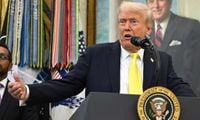On October 16, 2025, the Trump administration introduced sweeping changes to the H-1B visa program, raising the application fee to a staggering $100,000—a move that has sent shockwaves through the U.S. tech industry and beyond. The new policy, designed to tighten the flow of skilled foreign workers into the country, has left many companies scrambling to adapt, with some shifting crucial back-office operations overseas in response.
For years, the United States has been a magnet for global talent, particularly in the technology sector. According to Reuters, India accounts for a remarkable 70% of all U.S. H-1B visa recipients, with many of these skilled professionals finding employment at major American tech firms. The H-1B program has long been seen as a bridge between American innovation and the world’s brightest minds, but the latest fee hike threatens to upend that delicate balance.
The new $100,000 application fee represents a dramatic increase from previous costs, which typically ranged from a few thousand to around $10,000, depending on company size and other factors. The CEO of a tax services provider, speaking to Reuters, described the new fee as a “tough hurdle,” echoing the concerns of many business leaders who rely on international talent to maintain their competitive edge. "It’s not just a financial barrier—it’s a message that the U.S. is closing its doors to the world’s best and brightest," the executive said.
The immediate fallout has been swift. Companies faced with the prospect of paying six-figure fees for each skilled foreign hire have begun to reevaluate their hiring strategies. For some, the solution has been to move back-office work outside the U.S., seeking more welcoming environments for talent acquisition. This shift could have far-reaching implications for the American economy, potentially eroding the country’s status as a global innovation hub.
According to industry insiders, the impact is being felt most acutely in the tech sector, where competition for skilled engineers and developers is fierce. "This isn’t just about numbers—it’s about the future of American innovation," said a Silicon Valley recruiter who asked to remain anonymous. "If we can’t bring in the talent we need, we risk falling behind in fields like artificial intelligence, cybersecurity, and software development."
The timing of the policy change is notable, coming just one day before former President Trump made headlines with another bold claim: that India has halted its purchases of Russian oil. As reported by various outlets, this assertion has put a fresh spotlight on Delhi’s delicate balancing act in international relations, particularly as it seeks to maintain strong ties with both Washington and Moscow. While the veracity of Trump’s claim remains a matter of debate, the broader context is clear—U.S.-India relations are at a crossroads, shaped by shifting economic and geopolitical realities.
India’s dominant role in the H-1B program underscores the interconnectedness of the two countries. Many Indian professionals see the United States as the ultimate destination for career advancement and personal growth. For American companies, especially those in the tech sector, Indian talent has been nothing short of indispensable. The new visa fee, however, risks severing these ties, prompting Indian professionals to look elsewhere and American firms to consider relocating jobs to more hospitable markets.
As the CEO of the tax services provider put it, "We’re being forced to make tough decisions. If we can’t bring talent here, we have to go where the talent is." This sentiment is echoed across the industry, with some companies already setting up satellite offices in countries with more favorable immigration policies. The ripple effects are being felt not just in Silicon Valley, but in cities across the U.S. that have benefited from the influx of skilled foreign workers.
The Trump administration has defended the new policy as a necessary step to protect American jobs and ensure that U.S. workers are not displaced by cheaper foreign labor. Supporters argue that the higher fee will deter companies from abusing the system and encourage investment in domestic talent. "We need to put American workers first," a senior administration official told Reuters. "The H-1B program should serve the national interest, not just corporate bottom lines."
Critics, however, warn that the policy could backfire, driving innovation and investment overseas. They point to the fact that many of the world’s leading tech firms were founded or led by immigrants, and that restricting access to global talent could stifle the very dynamism that has made the U.S. economy the envy of the world. "This is a self-inflicted wound," said a spokesperson for a major tech industry association. "We’re making it harder for the next generation of innovators to come here and contribute."
The debate over the H-1B program is hardly new, but the stakes have never been higher. With the global economy in flux and technological change accelerating at a breakneck pace, the ability to attract and retain top talent is seen as critical to national competitiveness. The new fee structure, combined with broader uncertainties around U.S. immigration policy, has left many companies in a state of limbo.
Meanwhile, India’s position as the leading source of H-1B recipients remains a focal point in the broader conversation about U.S.-India relations. The claim by former President Trump that India has stopped buying Russian oil—though disputed—serves as a reminder of the complex interplay between economic policy, international diplomacy, and domestic politics. As Delhi navigates its relationships with Washington and Moscow, the fate of thousands of skilled Indian professionals hangs in the balance.
For now, the future of the H-1B program remains uncertain. Business leaders, policymakers, and workers alike are watching closely to see how the new fee structure will play out in practice. Will American companies continue to lead the world in innovation, or will they lose ground to competitors in Europe, Asia, and beyond? Only time will tell, but one thing is clear: the stakes could hardly be higher.
As the dust settles on the Trump administration’s latest move, companies and workers around the world are left to weigh their options—and their futures—in an increasingly uncertain landscape.




